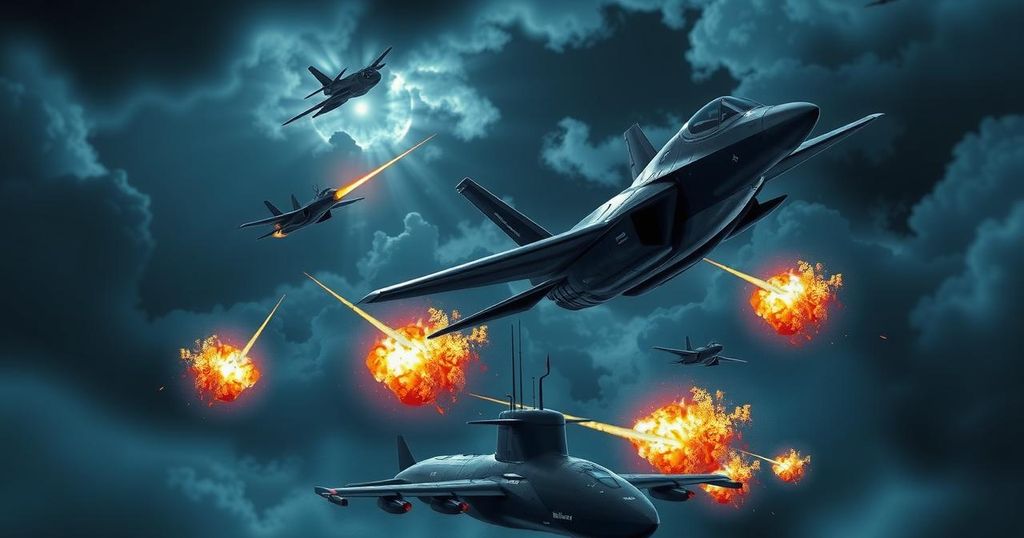11 Days in June: Trump’s Path to ‘Yes’ on Bombing Iran

President Trump ordered military strikes on Iran after an eleven-day escalation of tensions, marking a significant and risky foreign policy decision with implications for U.S. action in the Middle East. Initial troop relocations signaled potential conflict, culminating in airstrikes by Israeli forces and a decisive U.S. military operation. The situation reflects the complexities of Trump’s approach, balancing military readiness with diplomatic options, while highlighting critical security concerns in the region.
In a dramatic escalation of tensions, President Donald Trump has ordered U.S. military strikes against Iran, marking a pivotal moment in American foreign policy. The decision came after a fraught eleven-day period from June 11 to June 21, where Trump’s administration struggled between negotiation and military action. The strikes involved American stealth bombers, fighter jets, and a submarine targeting Iran’s nuclear capabilities, thrusting the U.S. into a high-stakes confrontation in the Middle East again.
The events leading to the strikes began on June 11, when families of U.S. troops were moved from the Middle East amid rising tensions. While Trump emphasized diplomatic solutions ahead of planned talks between Washington and Tehran, it became evident that military operations were already underway behind the scenes, with Israel’s military gearing up for action against Iran. Outcomes remained uncertain as many speculated whether heightened troop movements were genuine threats or tactical negotiations.
On June 12, confusion turned into chaos as explosions were reported in Tehran, killing key military personnel and demolishing sites linked to Iran’s nuclear program. Israel claimed responsibility for the high-profile strikes, deploying 200 warplanes and drones. Prime Minister Netanyahu characterized the operation as critical to Israel’s security while asserting that Iran posed an immediate threat. Trump responded ambiguously, reiterating a commitment to diplomacy but hinting at an aggressive stance.
The next day, Iran retaliated. Trump expressed admiration for Israel’s military capabilities, showcasing a shift towards a more hawkish tone against Iran. He still suggested diplomacy was preferable, indicating a complex balancing act between military readiness and the urge to negotiate. As the situation unfolded, Trump continued to praise Israel’s military efforts while pressing Iran to reach a peaceful resolution.
The situation intensified when Trump held discussions with Russian President Vladimir Putin, followed by the cancellation of U.S.-Iran talks and Israel’s claim of aerial supremacy over Iran. Back in the U.S., Trump marked his 79th birthday with a military parade, underscoring America’s formidable military presence amidst the looming conflict.
By June 17, Trump was demanding an “unconditional surrender” from Iran while expressing impatience with their leadership. Reports indicated that U.S. intelligence contradicted his assertion that Tehran was close to developing a nuclear weapon, a position he dismissed. On June 18, amidst speculation regarding potential U.S. involvement in strikes, Trump indicated he might consider direct action, emphasizing that prevention of nuclear armament was paramount.
As this gripping saga unfolded, findings suggested that Trump had to grapple with conflicting recommendations from military advisors and political pressures. On June 19, the president indicated a decision could be expected in two weeks, a timeline familiar to observing analysts, who have seen Trump regularly put forth such estimates without follow-through. The tension reached a peak on June 21.
In a pre-dawn operation, U.S. forces, utilizing stealth bombers and missiles, launched a surprising attack on Iranian military sites less than an hour after Trump returned to the White House from a fundraiser. His announcement characterized the attack as overwhelmingly successful while he warned of dire consequences if Iran retaliated. The situation remains volatile, with many analysts weighing the long-term implications for U.S. engagement in the Middle East.
In summary, the eleven days in June encapsulate a critical moment of decision-making for President Trump regarding military action against Iran, marked by a whirlwind of diplomatic maneuvering, military strikes, and escalating rhetoric. This period not only stands out for its rapid developments but also raises pressing questions about the future direction of U.S. foreign policy in a region fraught with tensions.
The timeline from June 11 to June 21 reveals the complexity and unpredictability of Trump’s approach to the Iran conflict. Starting with military evacuations and escalating into full-fledged strikes, the unfolding events underscore not just the reach of U.S. military power but also the challenges of diplomacy amid tensions. This period could redefine not only U.S. interactions with Iran but also the broader geopolitical landscape in the Middle East.
Original Source: apnews.com







